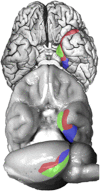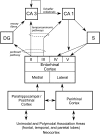Similarity in form and function of the hippocampus in rodents, monkeys, and humans
- PMID: 23754372
- PMCID: PMC3690603
- DOI: 10.1073/pnas.1301225110
Similarity in form and function of the hippocampus in rodents, monkeys, and humans
Abstract
We begin by describing an historical scientific debate in which the fundamental idea that species are related by evolutionary descent was challenged. The challenge was based on supposed neuroanatomical differences between humans and other primates with respect to a structure known then as the hippocampus minor. The debate took place in the early 1860 s, just after the publication of Darwin's famous book. We then recount the difficult road that was traveled to develop an animal model of human memory impairment, a matter that also turned on questions about similarities and differences between humans and other primates. We then describe how the insight that there are multiple memory systems helped to secure the animal model and how the animal model was ultimately used to identify the neuroanatomy of long-term declarative memory (sometimes termed explicit memory). Finally, we describe a challenge to the animal model and to cross-species comparisons by considering the case of the concurrent discrimination task, drawing on findings from humans and monkeys. We suggest that analysis of such cases, based on the understanding that there are multiple memory systems with different properties, has served to emphasize the similarities in memory function across mammalian species.
Conflict of interest statement
The authors declare no conflict of interest.
Figures



Similar articles
-
Spatial memory and the monkey hippocampus: not all space is created equal.Hippocampus. 2009 Jan;19(1):8-19. doi: 10.1002/hipo.20485. Hippocampus. 2009. PMID: 18727046 Review.
-
Alternative conceptions of memory consolidation and the role of the hippocampus at the systems level in rodents.Curr Opin Neurobiol. 2011 Jun;21(3):446-51. doi: 10.1016/j.conb.2011.04.007. Epub 2011 May 16. Curr Opin Neurobiol. 2011. PMID: 21592780
-
The medial temporal lobe.Annu Rev Neurosci. 2004;27:279-306. doi: 10.1146/annurev.neuro.27.070203.144130. Annu Rev Neurosci. 2004. PMID: 15217334 Review.
-
Evolution of declarative memory.Hippocampus. 2006;16(9):795-808. doi: 10.1002/hipo.20205. Hippocampus. 2006. PMID: 16881079 Review.
-
Memory and the hippocampus: a synthesis from findings with rats, monkeys, and humans.Psychol Rev. 1992 Apr;99(2):195-231. doi: 10.1037/0033-295x.99.2.195. Psychol Rev. 1992. PMID: 1594723 Review.
Cited by
-
Anatomical and Functional Comparison of the Caudate Tail in Primates and the Tail of the Striatum in Rodents: Implications for Sensory Information Processing and Habitual Behavior.Mol Cells. 2023 Aug 31;46(8):461-469. doi: 10.14348/molcells.2023.0051. Epub 2023 Jul 17. Mol Cells. 2023. PMID: 37455248 Free PMC article. Review.
-
On the Integration of Space, Time, and Memory.Neuron. 2017 Aug 30;95(5):1007-1018. doi: 10.1016/j.neuron.2017.06.036. Neuron. 2017. PMID: 28858612 Free PMC article. Review.
-
Finding and Not Finding Rat Perirhinal Neuronal Responses to Novelty.Hippocampus. 2016 Aug;26(8):1021-32. doi: 10.1002/hipo.22584. Epub 2016 Apr 18. Hippocampus. 2016. PMID: 26972751 Free PMC article.
-
Pathway-focused PCR array profiling of enriched populations of laser capture microdissected hippocampal cells after traumatic brain injury.PLoS One. 2015 May 27;10(5):e0127287. doi: 10.1371/journal.pone.0127287. eCollection 2015. PLoS One. 2015. PMID: 26016641 Free PMC article.
-
Adult Hippocampal Neurogenesis in Different Taxonomic Groups: Possible Functional Similarities and Striking Controversies.Cells. 2019 Feb 5;8(2):125. doi: 10.3390/cells8020125. Cells. 2019. PMID: 30764477 Free PMC article. Review.
References
-
- Darwin C. On the Origin of Species. United Kingdom: John Murray; 1859.
-
- Owen R. On the Classification and Geographical Distribution of the Mammalia. London: Parker; 1859.
-
- Gross CG. Hippocampus minor and man’s place in nature: A case study in the social construction of neuroanatomy. Hippocampus. 1993a;3(4):403–415. - PubMed
-
- Huxley TH. On the zoological relations of man with the lower animals. Natural History Review. 1861a;1:67–84.
-
- Huxley TH. On the brain of Ateles paniscus. Proceeding of the Zoological Society. 1861b:247–260.
Publication types
MeSH terms
Grants and funding
LinkOut - more resources
Full Text Sources
Other Literature Sources

